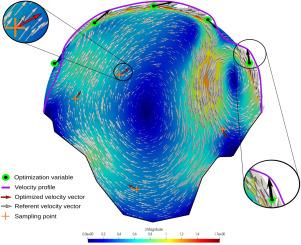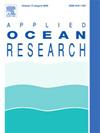Approximation of sea surface velocity field by fitting surrogate two-dimensional flow to scattered measurements
IF 4.3
2区 工程技术
Q1 ENGINEERING, OCEAN
引用次数: 0
Abstract
In this paper, a rapid approximation method is introduced to estimate the sea surface velocity field based on scattered measurements. The method uses a simplified two-dimensional flow model as a surrogate model, which mimics the real submesoscale flow. The proposed approach treats the interpolation of the flow velocities as an optimization problem, aiming to fit the flow model to the scattered measurements. To ensure consistency between the simulated velocity field and the measured values, the boundary conditions in the numerical simulations are adjusted during the optimization process. Additionally, the relevance of quantity and quality of the scattered measurements is assessed, emphasizing the importance of the measurement locations within the domain as well as explaining how these measurements contribute to the accuracy and reliability of the sea surface velocity field approximation. The proposed methodology has been successfully tested in both synthetic and real-world scenarios, leveraging measurements obtained from Global Positioning System (GPS) drifters and high-frequency (HF) radar systems. The adaptability of this approach for different domains, measurement types and conditions implies that it is suitable for real-world submesoscale scenarios where only an approximation of the sea surface velocity field is sufficient.

用散射测量拟合代用二维流来近似海面速度场
本文介绍了一种基于散射测量估算海面速度场的快速近似方法。该方法使用简化的二维流动模型作为代用模型,模拟真实的亚目尺度流动。所提出的方法将流速插值视为一个优化问题,目的是使流速模型与散射测量结果相匹配。为确保模拟速度场与测量值之间的一致性,在优化过程中对数值模拟的边界条件进行了调整。此外,还对散射测量的数量和质量的相关性进行了评估,强调了域内测量位置的重要性,并解释了这些测量如何有助于提高海面速度场近似的准确性和可靠性。利用从全球定位系统(GPS)漂移器和高频(HF)雷达系统获得的测量数据,在合成和实际场景中成功测试了所提出的方法。这种方法对不同领域、测量类型和条件的适应性意味着,它适用于只需近似海面速度场的真实世界次中尺度场景。
本文章由计算机程序翻译,如有差异,请以英文原文为准。
求助全文
约1分钟内获得全文
求助全文
来源期刊

Applied Ocean Research
地学-工程:大洋
CiteScore
8.70
自引率
7.00%
发文量
316
审稿时长
59 days
期刊介绍:
The aim of Applied Ocean Research is to encourage the submission of papers that advance the state of knowledge in a range of topics relevant to ocean engineering.
 求助内容:
求助内容: 应助结果提醒方式:
应助结果提醒方式:


